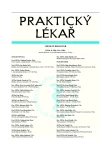DNA analysis and histological subtypes of endometrial cancer
Authors:
E. Radzo 1; P. Sýkora 1; Ľudovít Danihel 2; V. Šišovský 2; Vanda Repiská 1
Authors‘ workplace:
Univerzita Komenského, Bratislava, Slovenská republika
Lekárska fakulta
; Ústav lekárskej biológie, genetiky a klinickej genetiky
Prednosta: doc. MUDr. D. Böhmer, Ph. D.
1; Ústav patologickej anatómie
Prednosta: prof. MUDr. Ľ. Danihel, Ph. D.
2
Published in:
Prakt. Lék. 2010; 90(3): 171-173
Category:
Of different specialties
Overview
Introduction:
The total number of carcinoma of the endometrium (CaE) has a growing global trend. Most cases of CaE are classified as endometrioid histological subtype, which generally has a good prognosis and is treatable. The serous histological subtype of CaE is a rarer form of endometrial carcinomas; it has a worse prognosis and is diagnosed at later stages of disease. Given the prognosis of serous CaE it is useful and necessary to identify this subtype of carcinomas in mixed types of CaE.
Material and Methods:
We analyzed endometrial tissue in a group of 24 patients – the patients were between 44 and 88 years old. The histological findings of the samples studied varied from simple hyperplasia without atypia to endometrioid CaE with significant infiltration into myometria. The samples were also analyzed by direct sequencing and restriction analysis.
Results:
In all of the samples from the 24 patients with endometrial cancer or precancerous lesions, we identified a CCC/CGC Pro72Arg polymorphism in Exon 4. The ratio of heterozygous and homozygous polymorphisms was 14:10. The results suggest that there may be a mixed type of endometrial cancer.
Key words:
endometrium, carcinogenesis, TP53, DNA polymorphism.
Sources
1. Bonafe, M., Ceccarelli, C., Farabegoli, F. et al. Retention of the p53 codon 72 arginine allele is associated with a reduction of disease-free and overall survival in arginine/proline heterozygous breast cancer patients. Clin. Cancer. Res. 2003, 9(13), p. 4860-4864.
2. Fadare, O., Zheng, W. Endometrial glandular dysplasia: morphologically and biologically distinctive putative precursor lesions of type II endometrial cancers. Diagn. Pathol. 2008, 8, p. 3–6.
3. Chambers, J.T., Merino, M., Kohorn, E.I. et al. Uterine papillary serous carcinoma. Obstet. Gynecol. 1987, 69, p. 109–113.
4. Jia, L., Liu, Y., Yi, X. et al. Endometrial glandular dysplasia with frequent p53 gene mutation: a genetic evidence supporting its precancer nature for endometrial serous carcinoma. Clin. Cancer. Res. 2008, 14, p. 2263–2269.
5. Kazemi, M., Salehi, Z., Chakosari, R.J. TP53 codon 72 polymorphism and breast cancer in northern Iran. Oncol. Res. 2009, 18(1), p. 25-30.
6. Kouji, B., Megumi, Y., Yusuke, K. et al. Endometrial cancer as a familial tumor: pathology and molecular carcinogenesis. Current Genomics 2009, 10, p. 127-132.
7. Lax, S.F., Kendall, B., Tashiro, H. et al. The frequency of p53, K-ras mutations, and microsatellite instability differs in uterine endometrioid and serous carcinoma: evidence of distinct molecular genetic pathway. Cancer 2000, 88, p. 814-824.
8. Lax, S.F. Molecular genetic pathways in various types of endometrial carcinoma: from a phenotypical to a molecular-based classification. Virchows Arch. 2004, 444(3), p. 213-223.
9. Lomo, L., Nucci, M.R., Lee, K.R. et al. Histologic and immunohistochemical decision-making in endometrial adenocarcinoma. Mod. Pathol. 2008, 21, p. 937-942.
10. Malcikova, J., Smardova, J., Rocnova, L. et al. Monoallelic and biallelic inactivation of TP53 gene in chronic lymphocytic leukemia: selection, impact on survival, and response to DNA damage. Blood 2009, 114(26), p. 5307-5314.
11. Mutter, G.L. Endometrial intraepithelial neoplasia (EIN): will it bring order to chaos? The Endometrial Collaborative Group. Gynecol. Oncol. 2000, 76, p. 287–290.
12. Oluwole, F., Wenxin, Z. Insights into endometrial serous carcinogenesis and progression. Int. J. Clin. Exp. Pathol. 2009, 2, p. 411-432.
13. Silverberg, S.G., Kurman, R.J. (eds.) Atlas of tumor pathology, 3rd Series, Fascicle 3. Washington, DC: Armed Forces Institute of Pathology 1992, p. 13–14.
14. Tashiro, H., Isacson, C., Levine, R. et al. p53 gene mutations are common in uterine serous carcinoma and occur early in their pathogenesis. Am. J. Pathol. 1997, 150, p. 177-185.
15. Vogelstein, B., Kinzler, K.W. p53 function and dysfunction. Cell 1992, 70, p. 523-526.
16. Zaino, R.J. Endometrial hyperplasia and carcinoma. In: Haines M, Taylor CW, Fox H, Wells M, eds. Haines & Taylor Obstetrical and Gynaecological Pathology. Edinburgh: Churchill Livingstone, 5th ed. 2003, p. 445-446.
Labels
General practitioner for children and adolescents General practitioner for adultsArticle was published in
General Practitioner

2010 Issue 3
Most read in this issue
- Nosocomial infections
- Migraine and epilepsy comorbidity
- Aseptic meningitis as a manifestation of HIV primary infection
- Basal cell carcinoma of the skin – the most important risk and prognostic parameters of disease in clinical practice
